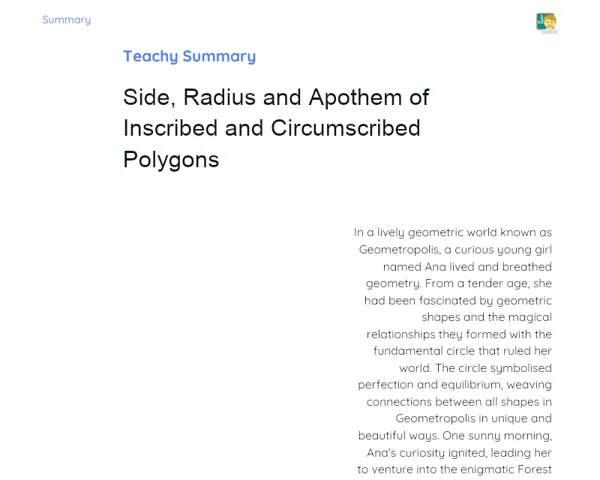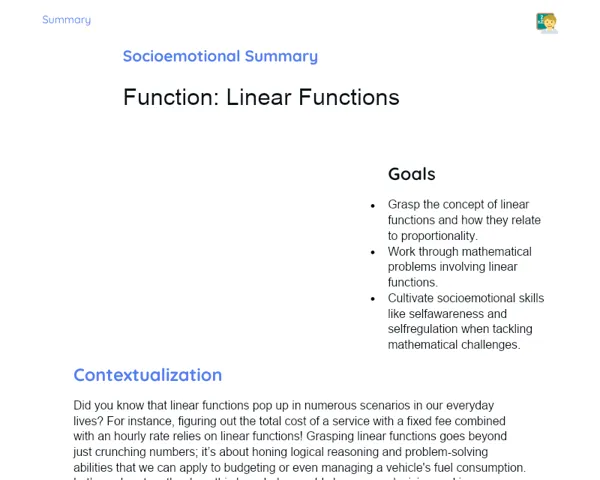Summary Tradisional | Angular Relationships in Parallel Lines
Contextualization
Today, we're diving into the angular relationships that arise when two parallel lines are crossed by a transversal. This is a fundamental topic in geometry, as these relationships appear often in various areas of maths and in real-world applications. When a transversal intersects two parallel lines, it creates eight angles, and grasping these angular relationships is key to tackling geometric and algebraic problems.
Understanding angular relationships helps us see how certain angles interact with one another. For instance, alternate interior and exterior angles are equal, while same-side interior angles add up to 180 degrees. These concepts find relevance in many fields, including architecture, engineering, and even in art, where attention to detail and symmetry hold great importance. Grasping these relationships not only assists in solving mathematical problems but also sharpens our ability to recognize patterns and structures in our everyday environment.
To Remember!
Angular Relationships in Parallel Lines Cut by a Transversal
When a transversal crosses two parallel lines, it forms eight distinct angles. These angles hold specific relationships with one another, which are essential in understanding various geometric challenges. By definition, parallel lines never meet, while the transversal is the line that crosses both, creating points of intersection that produce the angles.
We can categorise the angular relationships into four primary types: corresponding angles, alternate interior angles, alternate exterior angles, and same-side interior angles. Each type has its own distinct characteristics and properties. For instance, corresponding angles are those occupying the same relative position at each intersection and are equal, implying they share the same measure.
Grasping these relationships is critical for resolving problems involving algebraic expressions related to a variable, such as x. This knowledge is particularly useful in fields like architecture and engineering, where precision and understanding geometric properties are vital for the successful design and construction of structures.
-
Formation of eight angles when two parallel lines are crossed by a transversal.
-
Classification of angles into corresponding, alternate interior, alternate exterior, and same-side interior.
-
Importance of angular relationships in geometric and algebraic problems.
Corresponding Angles
Corresponding angles are those that occupy the same relative position at each of the intersections created by the transversal and the parallel lines. These angles are congruent, meaning they have the same measurement. For example, if a transversal crosses two parallel lines, the corresponding angles will be found on the same side of the transversal, both above and below the parallel lines.
The property of congruence among corresponding angles is a powerful asset in solving geometric problems. It allows us to set up equations based on the equality of angle measures, streamlining the process for finding unknown values. This concept is frequently used in geometric proofs and in tackling angle-related problems.
Furthermore, accurately identifying corresponding angles is vital for understanding other angular relationships. From the congruence of corresponding angles, one can infer the properties of alternate interior angles, alternate exterior angles, and same-side interior angles, establishing a robust foundation for analysing any configuration of parallel lines crossed by a transversal.
-
Corresponding angles occupy the same relative position at the intersections.
-
Congruence of corresponding angles (same measure).
-
Utilisation in problem-solving and geometric proofs.
Alternate Interior Angles
Alternate interior angles are positioned on opposite sides of the transversal but within the two parallel lines. Similar to corresponding angles, alternate interior angles are also congruent, indicating they share the same measure. This means that if we know the measure of one alternate interior angle, we can find the measure of the other alternate interior angle without needing to take any additional measurements.
The congruence of alternate interior angles is a significant property in geometry, aiding in the resolution of multiple complex problems. For instance, if an algebraic expression defines one of the alternate interior angles, that same expression can also be employed to define the other alternate interior angle, making it easier to solve equations and determine variables.
In addition to their usefulness in problem-solving, comprehending alternate interior angles reinforces the concepts of symmetry and congruence within geometry. This is especially relevant in fields that demand precision and mathematical accuracy, such as engineering and architecture, where measurement accuracy is essential for project success.
-
Alternate interior angles are positioned on opposite sides of the transversal, between the two parallel lines.
-
Congruence of alternate interior angles (same measure).
-
Importance in problem-solving and understanding geometric symmetry.
Same-Side Interior Angles
Same-side interior angles are situated on the same side of the transversal and lie within the two parallel lines. Unlike corresponding and alternate interior angles, same-side interior angles are not congruent but are supplementary. This means that the sum of the measures of the same-side interior angles equals 180 degrees.
The supplementary nature of same-side interior angles is a valuable tool for solving geometric problems. It allows us to create equations based on the sum of the angle measures, making it simpler to find unknown values. For example, if we know the measurement of one same-side interior angle, we can easily derive the measure of the other same-side interior angle by subtracting it from 180 degrees.
Understanding same-side interior angles is vital for a comprehensive analysis of the angular relationships present in parallel lines intersected by a transversal. This recognition lays a solid groundwork for addressing more complex problems and applying these concepts in practical scenarios, such as architectural design and force analysis in engineering.
-
Same-side interior angles are positioned on the same side of the transversal, between the two parallel lines.
-
Supplementary nature of same-side interior angles (sum equal to 180 degrees).
-
Utilisation in problem-solving and geometric analysis.
Key Terms
-
Angular Relationships: The relationships between the angles formed by parallel lines cut by a transversal.
-
Parallel Lines: Two lines that never meet, no matter how far they extend.
-
Transversal: A line that crosses two or more lines.
-
Corresponding Angles: Angles that are in the same relative position at each intersection.
-
Alternate Interior Angles: Angles found on opposite sides of the transversal, between the two parallel lines.
-
Alternate Exterior Angles: Angles found on opposite sides of the transversal, outside the two parallel lines.
-
Same-Side Interior Angles: Angles situated on the same side of the transversal, between the two parallel lines, whose sum amounts to 180 degrees.
Important Conclusions
In this lesson, we delved into the angular relationships formed by parallel lines cut by a transversal. We identified and explained corresponding angles, alternate interior angles, alternate exterior angles, and same-side interior angles, emphasizing their properties and how to use them in solving geometric problems. Understanding these relationships is essential in fields like architecture, engineering, and art, where precision and symmetry are fundamental.
The congruence property of corresponding and alternate interior angles, alongside the supplementary nature of same-side interior angles, were highlighted as efficient tools for tackling algebraic and geometric challenges. Knowing these properties simplifies calculations and allows for easy identification of unknown angles.
It’s crucial to recognise the practical applications of these angular relationships in our everyday lives, from construction designs to observing patterns in nature. The knowledge gained in this lesson provides a solid foundation for further exploring the vast world of geometry and its numerous practical applications.
Study Tips
-
Practice by solving geometric problems involving parallel lines and transversals, incorporating the properties discussed in class.
-
Review the concepts of corresponding angles, alternate interior angles, alternate exterior angles, and same-side interior angles, and try to identify them in various diagrams.
-
Look for practical examples in your local environment, such as architectural structures, to see how angular relationships manifest in reality.



